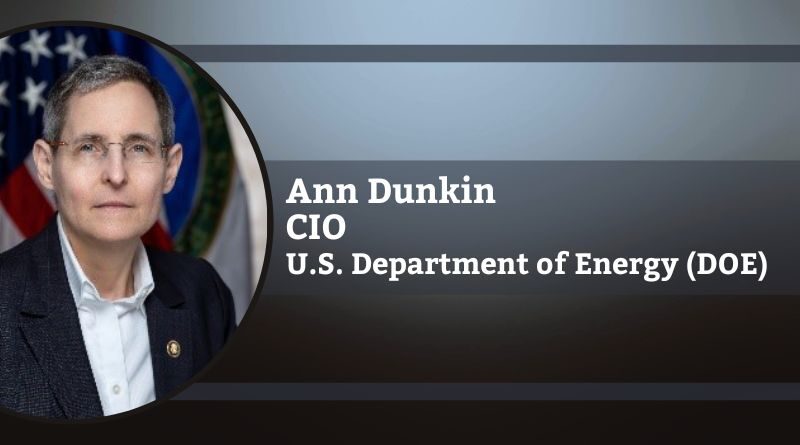Taking a Collaborative Approach to IT Modernization
By Ann Dunkin, Chief Information Officer, U.S. Department of Energy (DOE)
In today’s interconnected world, Federal agencies rely more than ever on technology to serve the nation. Citizens expect seamless digital access to critical services; the federal workforce expects secure and dependable IT services to enable mission delivery.
As Chief Information Officer (CIO) at the Department of Energy (DOE), I know that federal government technology does not have a reputation for being modern, intuitive, and reliable. I also know that we can do better and deliver much-needed digital transformation by focusing on IT service delivery, cybersecurity, innovation, and collaboration.
At DOE, we recognized an opportunity to scale from pockets of excellence to driving innovation across the organization, providing better, faster, and more secure services.
The US government’s digital transformation journey is already well underway. Beginning nearly a decade ago, we’ve seen increasing support from agency leadership, Congress, and the White House focused on cybersecurity, customer experience, and data strategy. We’ve seen pockets of excellence at DOE and other agencies, with teams adopting modern practices like Agile development methodologies and DevSecOps pipelines.
At DOE, we recognized an opportunity to scale from pockets of excellence to driving innovation across the organization, providing better, faster, and more secure services. We launched a collaborative effort to develop a roadmap to guide our progress, and we planned to share our work with peers in other agencies and sectors.
We built the Scaling IT Modernization Playbook, a resource that provides a set of “plays” – concrete roadmaps to help organizations implement change at scale.
Scaling IT, modernization refers to the actions that enable an organization to move towards comprehensive, coordinated, and enterprise-ready capabilities, thereby realizing the transformative value of IT modernization to achieve mission outcomes more quickly.
We knew the Playbook needed to be universally applicable to ensure utility across the federal government and that great ideas were distributed across many individuals, so we conducted in-depth interviews with IT leaders across industry and government and consulted with federal CIOs, CTOs, CDOs, and CISOs.
The final product is better and more impactful than I initially imagined. The plays are more powerful and innovative than we imagined when we started the work. The plays elevate IT modernization efforts, moving leaders to transform their organizations truly .
Leaders shared how technology was rarely the barrier when scaling IT modernization efforts. Time and again, transformation success came down to people, process, policy, politics, and culture – what one contributor called “soft-tissue issues.” After consolidating and analyzing the feedback, we grouped fundamental elements of scaling IT modernization into three main themes, each with a set of related plays:
- Mission Focused: Business-driven Innovation can be uniquely challenging for IT staff whose day-to-day work may be removed from the organization’s mission. In short: Value outcomes over process. Never pursue modernization for the sake of modernization. Ground IT modernization efforts in mission outcomes and improved customer service, whether the “customers” are government employees or the public. Key plays here focus on vision, mindset, and data adoption.
- Speed and Agility caution against underrating speed as value. Technology moves fast, and so should modernization efforts. Organizations must have the right tools, culture, and environment to enable true agility. Plays here focus on risk management, responsive cyber, building workforce culture, valuing learning, and delivering solutions.
- One Enterprise, One Government emphasizes coordination at scale. We must speed progress up by getting people to work together early and often. We must work together across the government to overcome common barriers, leverage relationships, and share assets that provide cost-of-efficiency advantages. Plays here focus on breaking down silos and building shared services.
Each play includes rationale, foundations, step-by-step actions, real-life examples of success, and key considerations. The Playbook is meant to be actionable. So, what does that look like?
In our Reframe Risk and Deploy Responsive Cyber play, we discuss the idea of reframing risk in ways that are consistent with mission goals and offer actions that transform the control and compliance mindset to one of responsible enablement for safe exploration. Another play, Elevate Coalitions, provides steps for building teams of early adopters and success champions. The Evangelize a Shared Vision play further demonstrates how a shared vision can break down silos within and across agencies and departments, setting the foundation to experiment together and share risk and resources.
The Playbook is only possible now because of the diligent work of developers and engineers who have worked to improve federal technology for years. It’s worth noting that some of the actions we once would have considered plays are now regarded as foundational components for enabling IT modernization: funding, talent, leadership, program vision, security, architecture, and governance.
Finally, while DOE authored the Playbook, if you’re a leader interested in scaling digital transformation within your organization, it’s a resource made specifically for you. It’s available for anyone to download and use as a tool to guide your modernization efforts.
As we saw while working on the Playbook, “none of us is as smart as all of us1.” We hope to hear your success stories and suggestions for improvement.
The Scaling IT Modernization Playbook is available to download on the DOE OCIO website: energy.gov/cio.
- We were unable to attribute this commonly used phrase to the original writer.

